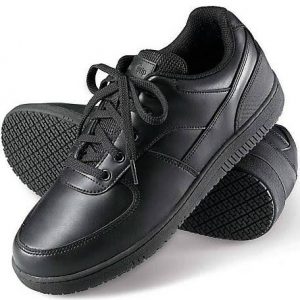Quick Navigation
Overview
Having resistant shoes is vital if you operate in areas that have oily or wet floors. Slip-resistant shoes are essential for runners, joggers, hikers, and other outdoor sports and activities. Having the right slip-resistant pair of shoes will enable you to reduce accident risks when performing. This article will expound on how slip-resistant shoes work.
What Is The Meaning Of Slip Resistant?
Slip-resistant shoes are designed to provide protection and guidance from slipping regardless of what might be on the surfaces like grease or water. The shoes don’t guarantee that you won’t slip; however, it is less likely that you slip. Slip-resistant shoes are crafted with soles; it has rubber soles and significant tread patterns. See the difference between oil resistant and slip-resistant shoes
How Do Slip Resistant Shoes Work
Slip-resistant shoes are made to reduce trips, slips, and falls. Trips and slips have been seen as the major causes of several workplace accidents in the United Kingdom. According to official reports, falls, trips, and slips make up 44 percent of all office injuries. Be that as it may, how do the slip-resistant shoes work exactly?
Shoes that have greater friction possess deeper tread grooves. The deep grooves against falls and slips because they grip well on the ground. The more grooves on your shoes, the more slip-resistant it will be. Averagely, the friction you receive for each of the tread grooves is between 0.018 to 0.108; however, this is based on the floor condition or surface on which you are walking.
Also, the pattern shape on the outsole can affect the grip of the shoes. Multiple designs and especially circle outsoles enhance grip, particularly on oily or wet floors. A flat shoe will prevent the liquid (on the floor) from leaving the shoe base; thus, you might have more probability of slipping when you are walking.
The shoe tread is crafted to give you an excellent grip on wet areas or surfaces. If the shoes are flat and have no prints, then it possesses no grasp, and you have more probability of having an accident than a person who wears slip-resistant shoes. The treads provide traction, so if you attempt to feet slide on the floor, the print (tread) will grip well to the floor. If you are running or walking, your shoe tread will grip to the floor or ground. When you meet a wet floor and aren’t wearing slip-resistant shoes, you will likely fall.
What’s more, the tread material on slip-resistant shoe aids in resisting slips. The excellent grade rubber has successfully gripped on greasy conditions or surfaces and offers powerful traction.
Few features distinguish slip-resistant shoes from other shoes. The features include; the patterns, materials, and outsole designs. Here is a practical categorization of slip-resistant shoes that makes them unique from regular ones:
The Material
Materials used to design the shoe might break or make it. The material utilized in producing a shoe is considered if they have direct contact with the floor. A slip-resistant shoe is always soft on the outside that makes them grip the slick floor effectively. The outer part of the shoe can’t be made from any material other than rubber, making it more resilient to oil and water. As hinted earlier, the rubber used in the outsole enables it to have more resilience against foreign compounds. The soft make-up of the rubber offers an efficient floor grip. The materials also provide an efficient grip on quarry or hardwood tile or even linoleum flooring better than several regular outsoles, which are stiffer on the outside; this makes the shoes better slip-proof.
The Design
Though difficult to believe, the design of a shoe makes it to be more slip-resistant. The rationale behind it is that most shoe designers who equally make shoes for basketball and other series of athletic shoes test if the shoes will work on hardwood floors or fields. They try out shoes’ performance against various weather conditions; this is the same with the slip-resistant shoes, with the shoemakers working tediously to make sure it operates best on any given surface or state.
The Pattern
The slip-resistant pattern may have been less emphasized; however, the right structure in the shoes’ outsole breeds the traction that offers an excellent grip for the shoe wearer not to slip under any condition or circumstance. Several shoes, with interlocked tread patterns that are ingrained under the shoe outsole, become exceedingly slip-resistant. The enclosed tread pattern removes the liquid from moving inside the outsole, which makes them be more slip-resistant. The tread with interlocked pattern doesn’t entrap fluid or water in your shoe; however, it prevents water from reaching contact with your foot. Hence, making sure that the foot is secured in any stand or position.
Finally, in this section, when you make the design, materials, and pattern of the outsole the same, it will make the shoes exceedingly slip-proof. It is an essential and ideal combination that enables everything to be secured and safe in any of your dangerous conditions.
Difference between a Slip resistant shoe and a Normal Shoe
From the names, it will be easy to distinguish between the two. A slip-resistant shoe is a common type of safety shoe. The slip-resistant shoes are made to prevent wearers from falling or slipping on oily, wet, or slick surfaces, unlike regular footwears. The primary feature that sets the resistant shoes apart from conventional shoes is a rubber sole that allows for better traction and grip. A person can decide to make his shoes slip resistant.
Conclusion
Having slip-resistant or commonly called non-slip shoes is mandatory in some workplaces and for anyone who usually runs, walks, or works on floors that get slippery, wet, and oily. Having the right slip-resistant shoes can aid in preventing awful accidents. Those who work in construction, food service, manufacturing, catering, and health care centers achieve a lot from wearing resistant slip shoes. See how to choose non-slip shoes for the elderly ‘

